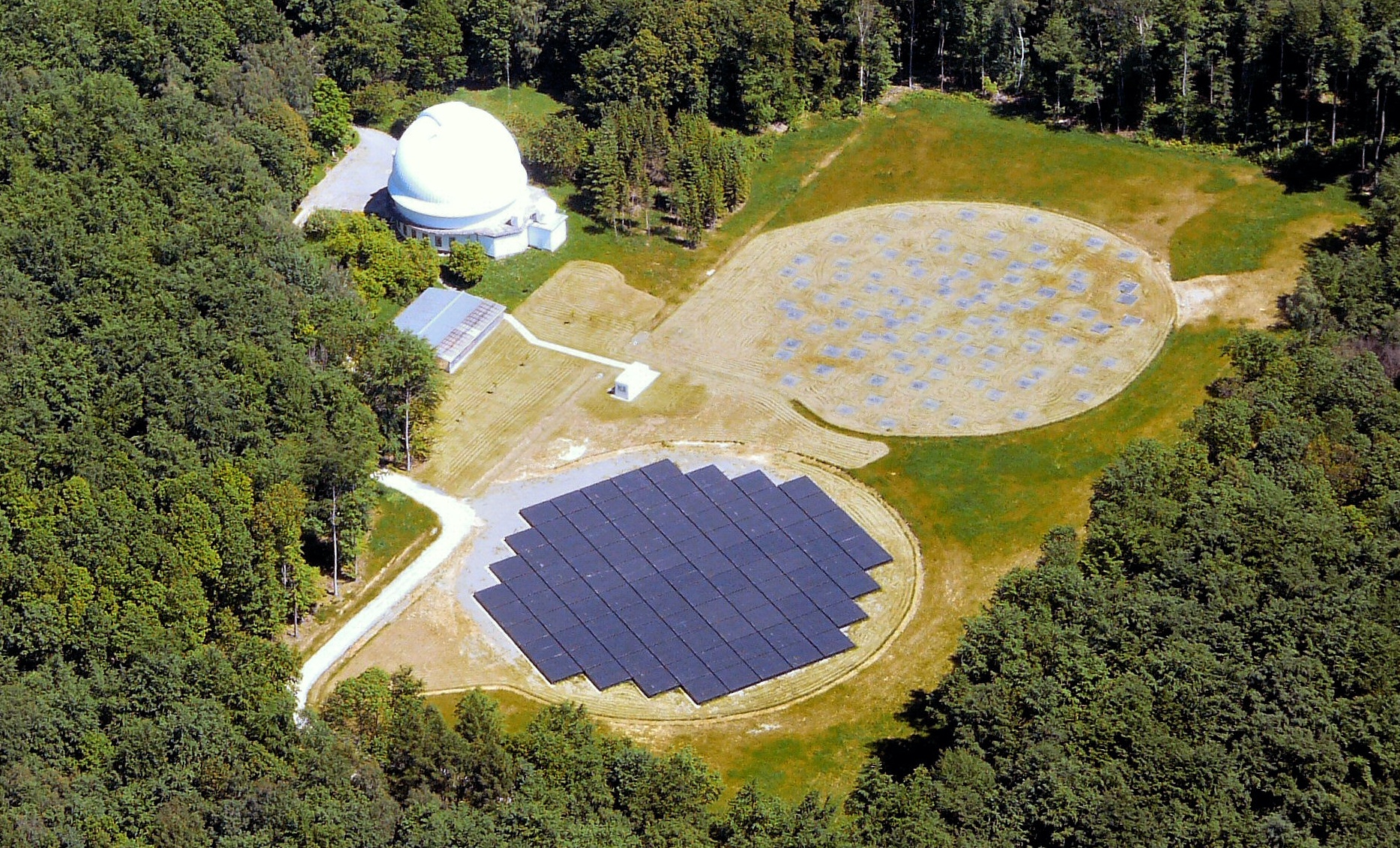The last regular observation cycle of the first generation of the LOFAR radio telescope ended on May 31, 2024. The radio telescope will be upgraded over the next two years. On June 10, 2024, the founding of the LOFAR European Research Infrastructure Consortium (LOFAR ERIC) was celebrated.
When you work at the Thuringian State Observatory you are familiar with the LOFAR field. The radio telescope is located behind the 2-Meter Alfred-Jensch-Telescope. It consists of two antenna fields: one for the low band antennas, ranging between 10 and 90 MHz, and one for the high band antennas, ranging between 110 and 250 MHz.
 The LOFAR station in Tautenburg shortly after it was built. Photo: TLS / Michael Pluto
The LOFAR station in Tautenburg shortly after it was built. Photo: TLS / Michael Pluto
The Tautenburg station of the European radio telescope LOFAR (Low Frequency Array) was put into operation in 2010. LOFAR began as a national project in the Netherlands and now comprises more than 50 stations across Europe (as of 2024). This joint project fundamentally advanced low-frequency radio astronomy and led to a wealth of scientific publications.
LOFAR is the world's first radio telescope that made it possible to create detailed maps of the sky at very low radio frequencies for the first time. With these maps, scientists can, for example, study the effects of black holes in distant galaxies and trace the history of star formation in the development of the universe.
Researchers at the Thuringian State Observatory played a leading role in data processing for the "LOFAR 2 Meter Sky Survey". Around half of the data collected for this survey was processed by Dr. Alexander Drabent, scientist at the Thuringian State Observatory.
The station in Tautenburg was the second international station outside the Netherlands. The first radio sky image with the Tautenburg LOFAR station was recorded back in April 2009. After 14 years of observation, it is now time for further development.
More detailled observations
Over the next two years, the radio telescope will be transformed to "LOFAR 2.0". The electronics will be improved so that even more precise observations can be made. Dr. Alexander Drabent explains, how: "The processing capacity will be increased so that the radio telescope will be able to process more signals simultaneously than before." For this purpose, the hardware is being upgraded.
Each LOFAR station consists of two antenna arrays. Until now, it was possible to observe with either one or the other field. In the future, it should be possible to receive radio signals with both arrays at the same time.
Joint further development under a new structure
The radio telescope is not only getting a technical upgrade, the legal form has also been adapted to the international research project. LOFAR was previously organized as a Dutch foundation. At the beginning of 2024, LOFAR was transferred to an independent legal form: a consortium for a European research infrastructure, known as the European Research Infrastructure Consortium (ERIC).
 Reception at Dwingeloo, Netherlands, to celebrate LOFAR ERIC, Photo: ASTRONThe European Commission decided to establish LOFAR as a European research infrastructure consortium due to the Europe-wide importance of the radio telescope. The LOFAR ERIC Council officially founded LOFAR ERIC on January 22, 2024, following several years of preparations to make the international LOFAR telescope fit for the future with the new European legal form.
Reception at Dwingeloo, Netherlands, to celebrate LOFAR ERIC, Photo: ASTRONThe European Commission decided to establish LOFAR as a European research infrastructure consortium due to the Europe-wide importance of the radio telescope. The LOFAR ERIC Council officially founded LOFAR ERIC on January 22, 2024, following several years of preparations to make the international LOFAR telescope fit for the future with the new European legal form.
"The new organizational structure as European Research Infrastructure Consortium reflects the participation of many European countries and enables them to further develop LOFAR together," explains Professor Dr. Matthias Hoeft, Deputy Director of the Thuringian State Observatory. He coordinates the German LOFAR consortium. This means that the Thuringian State Observatory represents German scientific interests in the LOFAR ERIC Council as so-called Representing Entity.
On June 10, 2024, Professor Dr. Hoeft, and the Director of the Thuringian State Observatory, Professor Dr. Markus Roth, attended the founding ceremony of LOFAR ERIC in Dwingeloo. The reception took place at the headquarters of the international radio telescope at ASTRON in the Netherlands.

